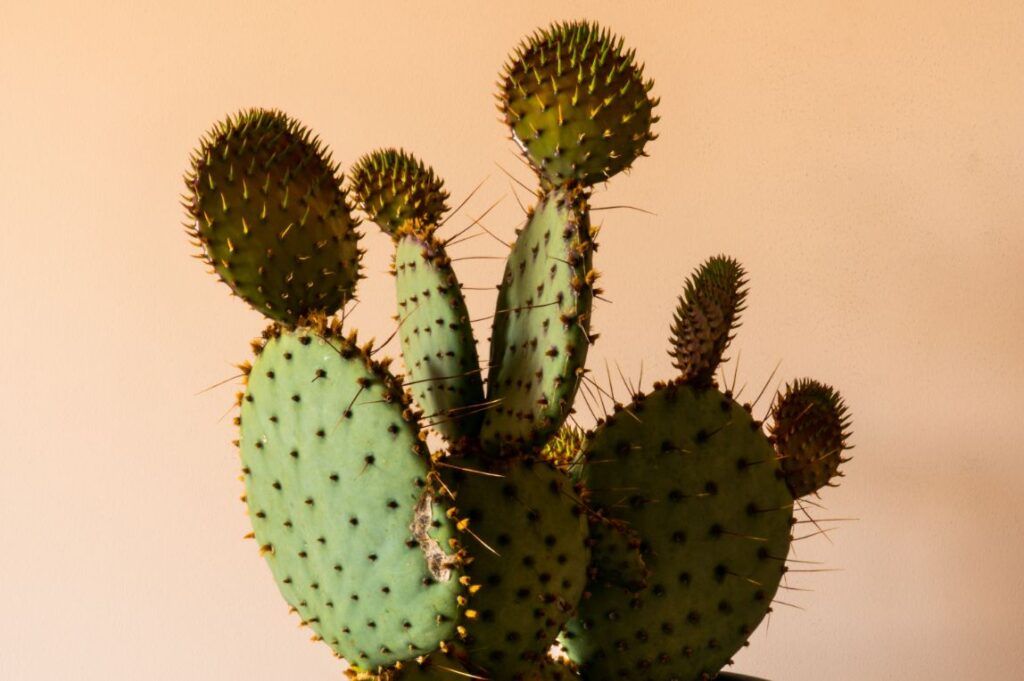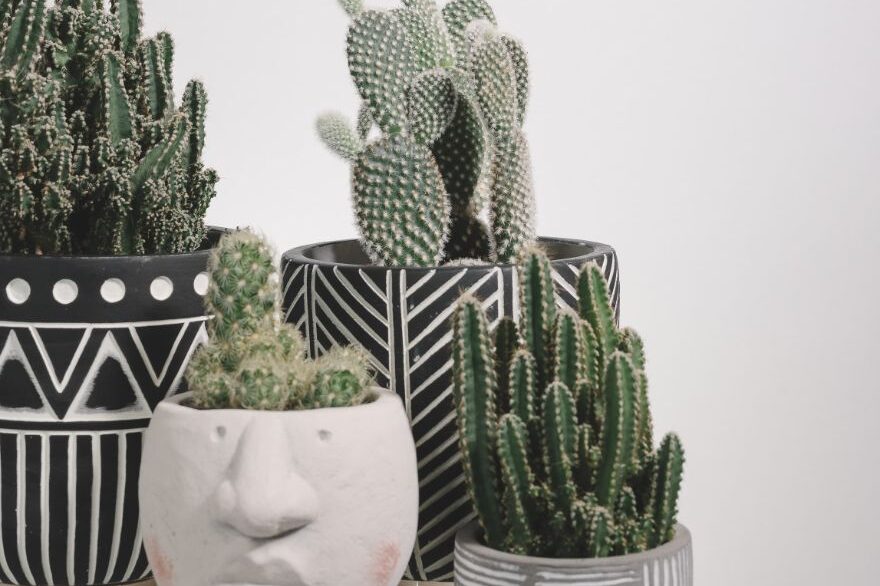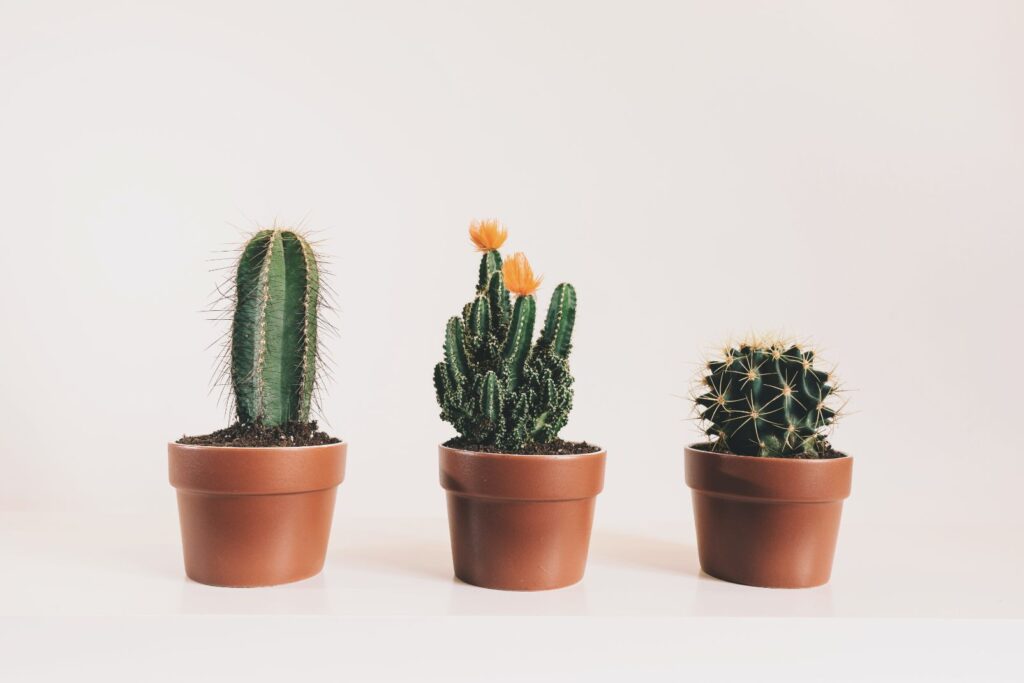In this article, we’ll go over exactly how to water cactus plants, including the key factors to keep in mind, when to water, and how to water.
When should a cactus be watered? Once the soil has completely dried out, most cacti should be watered. To determine when to water a cactus, keep an eye on its health and the amount of dryness in the potting mix rather than following a schedule.
How frequently to water cactus plants depends on a number of variables, including the size of the cactus, pot size, season, temperature, and humidity. It’s important to know what your cactus needs in terms of water. To learn more about your cactus watering requirements, continue reading.
Further Reading: Are Christmas Cactus Poisonous to Cats or Dogs?
- How Often Should You Water a Cactus?
- How to Water a Cactus?
- When to Water a Cactus?
- What Type of Water is Best for Cactus Plants?
- Factors to Consider When Watering Cactus
- Size of Pot Affects How Often to Water a Cactus
- Type of Pot and Drainage
- Type of Potting Media
- Ambient Temperature and Airflow Impact How Often to Water Cactus Plants
- Humidity Impacts How Often Water Cacti
- Light Conditions
- The Species Affects How Often to Water a Cactus
- Conclusion: Water Your Cactus
How Often Should You Water a Cactus?
Cacti are hardy plants that can endure inclement weather, as is common knowledge. During a prolonged drought, their stems and roots will serve as a water reserve to keep them alive.
Despite this, it doesn’t necessarily follow that you ought to give them more time. They will live, for sure, but they won’t develop to their full potential, let alone flourish. You need to water your cacti more frequently if they are currently in their growing season.
Typically, the growing season of a cactus occurs from spring to fall or during the warmer months. You must water your cactus once every seven to ten days between March and October.
Your cactus, on the other hand, is past its growing season in the cooler months, or from October to March. Only once or twice a month should you water them.

The Essentials:
- Only water cacti when their potting soil is at least 90% dry.
- As succulent plants, small to medium-sized indoor cacti will typically need to be watered every 10 days or more during spring or summer months, and every 4 to 6 weeks during winter.
- The best way to water cacti is to completely saturate the soil with rainwater or distilled water, and then stop when water begins to drain from the drainage hole in the potting container.
How to Water a Cactus?
Okay, so how frequently should you water a cactus? There is a general rule of thumb that can be applied to most varieties, even though it can depend on a variety of the various factors that we’ve already discussed.
A cactus should be watered once a week during the hottest months, according to the majority of horticulture experts. This is typically the ideal quantity to provide sufficient moisture without allowing too much water to remain in the soil and soak the roots.
When it’s time to water, make sure the soil is completely wet. The soil is fully saturated when water is slowly dripping out of the drainage holes in the bottom of the pot. You can use a water gauge or your finger if the cactus is in the ground.
Signs of An Underwatered Cactus
The most frequent cause of health issues for cacti is overwatering, but underwatering can also occur. Either one could be detrimental to your cactus. Keep a close eye out for indications of improper watering on your cactus. Look out for these symptoms of underwatering:
- The cactus is discoloring, turning light green or yellowish
- Its spines are turning brown or falling off
- The cactus is wilting
- Pads are withering or drooping
- The base of the cactus is decaying and turning brown

Simply give it a good soak in water and watch it recover if you notice any of the aforementioned symptoms.
Signs of An Overwatered Cactus
Since its effects are frequently permanent, excessive water can be more harmful to the health of your plant than underwatering. Here are signs that you may have overwatered your cactus:
- The skin of some of the cactus pads is starting to split
- Pads seem to have wrinkles or folds
- The soil remains moist for too long
- The pads and base of the cactus are turning brown or black
- Plants appear overly plump
Waterlogging in the soil is caused by excessive irrigation. This is detrimental to the cactus and can cause root rot very quickly.
When to Water a Cactus?
You should be aware when your plant is in trouble as the owner. You may notice a slight change in the appearance of your cactus if it needs water urgently.
Your cactus will typically appear brown and dry. If it were submerged, it would also contract, shrivel, and pucker.
Before actually watering a cactus, there is no need to wait for it to show obvious signs of being underwater. To know the optimal time when to water your cactus, check these steps:
- Insert your finger into any or all of the drainage holes in your cactus pot. You don’t need to water your cactus if you can still feel some moisture. You only need to wait a few more days or weeks.
- Gently push a small skewer or stick through the potting mix’s bottom, wait a few seconds, and then pull it out. If the stick appears damp or if there is still apparent moist soil sticking to it, feel the stick. If it is, hold off on watering for a few days.
- You should be able to dig your finger a few inches into the potting mix at the top. It is time to water the mixture and soil if they feel dry. Your cactus won’t suffer if you put off watering as long as the soil is moist and damp and has some potting mix that still adheres to your fingers.
In essence, you want the soil to be dry before you add any water. Look inside the soil or potting mix as well, as it may still be wet there, rather than just at the top or bottom.
What Type of Water is Best for Cactus Plants?

A healthy plant also depends on the type of water it receives. For an indoor cactus, the best options are rainwater and distilled water.
Rainwater, as opposed to soft water, hard water, or tap water, has the ideal ratio of minerals for cactus plants. Other types of water contain a lot of minerals that can accumulate in the soil and harm your plants.
Factors to Consider When Watering Cactus
Here are nine of the most important variables that affect how frequently to water cactus plants.
Size of Cactus
It stands to reason that a cactus would require more frequent watering the larger it is. However, young, smaller cacti typically grow more quickly and need and use more water in proportion to their size.
In addition to having a larger volume-to-surface area ratio, larger cacti also have less water evaporating from their surface.
When you do water a cactus, you usually have to give it a lot more water, but you might find that smaller, faster-growing cacti that are planted in smaller pots actually need more frequent watering and closer monitoring.
Size of Pot Affects How Often to Water a Cactus
Large pots have more potting soil, which means it takes longer for a cactus to absorb the water therein or for the water to drain or evaporate.
Smaller surface-to-volume ratios are also a characteristic of larger pots. As a result, a cactus planted in a large pot may only require watering every 4-6 weeks or more, whereas a cactus planted in a very small pot may only require watering once a week or less.
Because they don’t like to stay in water for too long, most cacti do better in smaller pots. It can be really difficult to avoid root rot if you have a cactus planted in an oversized pot, so if you are having problems, repot your cactus into a pot that is just large enough for the cactus and no more
Type of Pot and Drainage

The best method for caring for cacti is to provide a lot of water, let the extra quickly drain, and then watch as the potting medium quickly dries. It will take longer for the potting media to dry out because plastic pots will hold moisture.
Because terracotta pots are porous, the water in the potting mix will slowly evaporate into the air as it passes through the walls of the pot, significantly speeding up the process of potting mix drying.
Similarly to this, pots with lots of drainage holes are much better because they enable excess water in the potting media to quickly drain out of the pot. In general, trying to grow cacti in pots without holes is a miserable experience. Although it is possible, root and stem rot is much more likely to result. I speak from bitter experience!
Type of Potting Media
Make sure the potting medium is quickly draining to ensure success with cacti growing. Any commercial cactus mix will work, or potting soil, coarse sand, and perlite combined for a great DIY alternative.
A well-draining mixture will make it simple for extra water to drain away and speed up the soil’s drying time. It goes without saying that you will need to water your cactus more frequently as a result, but it will appreciate it.
Ambient Temperature and Airflow Impact How Often to Water Cactus Plants
Evaporation from your cactus and from the soil surface increases as the temperature rises. Additionally, higher temperatures typically indicate that the plant is actively growing and consuming more water.
During the cooler winter months, when your cactus isn’t growing much, you might only need to water the plant every 4-6 weeks. However, during the hot summer months, when the plant is growing, you might need to check the potting soil’s dryness every few days.
Cacti are wonderful because they can withstand being submerged very well. Therefore, if you water the cacti a little slowly, they won’t suffer too much, but overwatering is the root of all the problems.
Evaporation is influenced by temperature as well as airflow. Remember this, especially if you move your cactus outside during the summer when ventilation will be much higher and water needs will rise considerably.

Humidity Impacts How Often Water Cacti
In arid conditions, evaporation rates will be higher. Wet potting soil will dry much more quickly because there is plenty of room for more water to be absorbed by the air.
When caring for the majority of indoor plants, it’s a good idea to keep an eye on the humidity levels because it can help you determine when watering is necessary. Even in a humid interior, you can still have great success with cacti as long as you keep an eye on the soil’s dryness. Cacti thrive in arid climates, though.
Light Conditions
The rate of evaporation and the rate at which your cactus soil dries out will both increase in direct sunlight. You will need to water your cactus much more frequently if it is kept in a south-facing window than in a cooler north-facing room.
The Species Affects How Often to Water a Cactus
Every plant has different watering needs, and cacti are no different. How frequently you need to water your cactus depends on what kind you choose to grow at home.
For guidance on how frequently to water your cactus, consult the specific species as some cacti prefer a little bit more water than others.
The Time of Year Will Affect the Water Requirements of Cactus Plants
Cacti require frequent watering during the summer and the active growing season. During the colder, dormant winter months, cacti typically require less water. During this time, you can reduce the amount of water you use by at least 50% or even more.
Conclusion: Water Your Cactus
It can take some trial and error to determine when to water cactus. In order to encourage growth, flowering, and fruiting in cacti, proper watering is essential. Being a lover of cactus houseplants means keeping an eye out for any signs of distress.
Just keep in mind to water cactus plants wisely and to identify the variety and country of origin of the ones you have. Consequently, choosing when to water plants may be much simpler.









